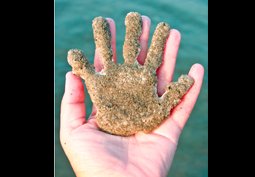By: Julie Finn
The beach is one vacation spot that ensures that you come away with beautiful souvenirs.
A handful of sand, the choicest of clam shells, rocks worn smooth by the waves, as much driftwood as your trunk will hold- any of these free natural objects make for timeless, treasured souvenirs.
But how can you record something just as precious, but just the opposite of timeless? How can you take home and treasure something as ephemeral as a footprint in the sand, or the smallness of your child’s hand the day that she first saw the Atlantic Ocean?
My girls and I have been very into plaster of Paris projects this summer. It turns out that plaster of Paris forms just as well in an easy mold of beach sand, one that you can create right on the beach, and it mixes just as well with sea water as it does tap water, and it leaves on the surface of your print a fine layer of embedded sand, perfect for recording a special trip to the ocean.
You will need:
- Plaster of Paris: One-and-a-half cups of plaster of Paris is enough for four handprints of a small child, two footprints of a small child, one child’s handprint and one adult’s handprint, or one adult’s footprint.
- Resealable plastic bag that’s at the end of its useful life. This is a good project to finish off the bag from yesterday’s lunch, or the bag that your deli cheese came in, or the bag that the treat came home in from the last birthday party that your child went to. Plastic bags, when used sparingly and only when they’re really useful, will help you do this project neatly and efficiently and with as little trash as possible.
- Measuring cup
- Watertight pail
1. Before you go to the beach, measure out the appropriate amount of plaster of Paris and put it into a resealable plastic bag. Read the directions on your container of plaster to be sure, but generally the ratio is 1:1.5, water to plaster of Paris. Sometimes I write how much water I’ll need to add directly onto my bag- otherwise, I tend to reverse the ratio and ruin my batch.
2. When you pack for the beach, bring that bag of plaster of Paris, a measuring cup for adding the seawater, and a pail for toting the water.
3. At the beach, find a spot of clean sand. For a handprint or footprint, you’ll want to use somewhat damp sand, like what you get below the high tide line. This sand will hold an impression the best and make the clearest, sharpest mold.
If your little child is having trouble making a firm impression into the damp sand, till it up and smooth it back down to make it easier to shift.
4. Put a hand or foot firmly down into the sand, then lift it straight back up. You want a relatively deep impression here, or your finished mold will be very thin. You will likely need to gently but firmly press down on a child’s hand or foot to help him or her make a deeper impression than she or he has the strength to do on his or her own.
Alternately, you can also dig and draw into the sand to make your own artistic mold.
5. Carry up some seawater in your pail, then add the appropriate amount of seawater to the plaster in your bag and seal it closed.
6. Knead and agitate the plastic bag until the plaster is completely mixed. This is even easier than mixing your plaster in a bowl, since you can easily feel if there are any lumps remaining in your bag.
7. Open one end of the plastic bag, then pour the plaster to fill all your molds.
8. Use the directions that came with your plaster to determine how long you should wait before you unmold your handprint. Depending on the temperature of the sand, you may have to wait longer than the directions indicate before your plaster has cured.
9. Gently excavate your print, give it a quick rinse in the ocean, and you’re done!
Now you have your beach sand souvenir and a keepsake for the grandparents, as well.



